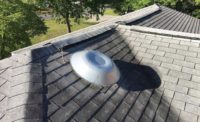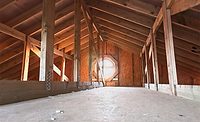Air Vent's Travelling Air Show Reaches Roofing Contractors

Trying to use an exhaust vent low on the roof as an intake vent is potentially problematic. There are better ways to achieve intake than to incorrectly use an exhaust vent. Photo courtesy of Air Vent Inc.
NOVI, Mich. — When Air Vent Inc. takes its “Attic Ventilation: Ask the Expert” seminar on the road, John Noel usually attends one of the Michigan stops, taking in as much info as possible.
Noel, owner of Harrison Township, Mich.-based A-1 Roofing and Siding, was among the crowd of roofing contractors there in Michigan hotel in late March. It was near the end of Air Vent’s 27-stop tour that ran during the 12-week first quarter and saw more than 2,000 attendees. Air Vent has hosted the seminars annually for the last 21 years.
More than 100 people from the metro Detroit area attended the Novi stop.
Over the years, Noel said he has attended Air Vent’s seminar 15 times.
“I keep coming back to continue refreshing,” Noel told RC. “With what we do in roofing, to go in and present ventilation (to a homeowner), to explain the ins, the outs, the whys…the way the information is presented here just makes good sense.”
The information is presented by Paul Scelsi, communications manager, Air Vent.
“The primary benefit is we help share known best practices from roofing professionals that have worked across North America,” Scelsi said after the Novi seminar. “So hopefully we’re all doing improved best practices as an industry…and hoping to help the contractor get better at what he or she is doing.”
Scelsi said the event also serves the company’s brand-building efforts as Air Vent is host and its products are featured throughout the seminar.
For the most part, however, the seminar involves attic ventilation tips and info that can apply to products made by any vent manufacturer.
“This seminar has evolved into nothing more than a collection of best practices that we’ve been able to collect from your peers all across the country neatly packaged into a fast-moving, two-hour format we’re going to share with you right now,” Scelsi said as his kicked off the presentation.
Digging Into Vent Details
Scelsi told attendees that the information presented largely draws from “Principles of Attic Ventilation” — a 17-page booklet handed out at the seminar and available in PDF form from the Air Vent website.
It starts with the basics of why ventilation is important (to keep attics cooler in the summer, reduce moisture/prevent ice dams in the winter). Scelsi first talked about the extra stress that can be put on a roof via heat buildup when an attic is not properly vented.
“Research shows shingles on unvented decks could receive a 10 percent service life reduction,” Scelsi said. “Is 10 percent really that big of a deal? We suggest, why don’t you check with the homeowner who’s about to fork over several thousand dollars for a new roof?”
He also talked about how ill-vented attics can lead to damage in the winter.
“The average family of four generates two to four gallons of water vapor every day from…cooking, cleaning, laundry…it’s over a gallon a day from breathing and perspiration,” Scelsi said, noting other factors contribute, such as pets, plants, and firewood stored indoors.
“Where’s the water vapor go? Some of it rises to a cooler, drier place, the attic,” he said. “And if we don’t get it out of the attic properly, potentially it will condense as frost or water droplets, drop into the insulation…and in time, we might be looking at mold, mildew, wood rot, indoor air quality could be affected.”
Throughout the seminar, Scelsi talked about the importance of attic ventilation being balanced, or having as much air coming into the attic as there is going out.
“This is the essence of the entire two-hour program,” Scelsi said. “It’s a big deal.”
Scelsi noted that the Asphalt Roofing Manufacturers Association and National Roofing Contractors Association both recommend balanced attic ventilation in their respective lists of best practices.
To achieve balanced ventilation, Scelsi explained, there are generally two types of exhaust vents: motorized or non-motorized.
The effectiveness of non-motorized vents is measured in NFA (net free area), or the total unobstructed area (typically measured in square inches) through which air can enter or leave an area.
The effectiveness of motorized vents is measured in CFM (cubic feet of air moved per minute).
NFA and CFM ratings are associated with each type and size of vent. The ratings effectively determine what how many vents to use, depending on type of vent and square footage of the attic.
When it comes to types of exhaust vents available, Scelsi said there are five: roof louvers; turbines; gable/wall louvers; powered fans; and ridge vents.
Scelsi noted that Air Vent makes products for each category, but called ridge vents “the best of the five.”
“It’s the only one of the five that’s going to give us continuous flow of air from low on the deck to high on the deck, along the entire horizontal peak of the deck,” he said. “We’re installing this thing end-to-end on the roof. Balance it down low with good intake? No air flow dead spots.”
Like exhaust fans, there are various types of intake vents: soffits; undereave vents; vented drip edge; edge vents; and low-profile vents like Air Vent’s ShadowHawk (which can double as an exhaust vent).
Scelsi said far too often, intakes don’t get enough attention. He recommended roofers either include them as part of their service or actually refund homeowners part of the money they paid so that they can cover the costs involved with proper intake installation.
“Intake drives the callbacks we track,” Scelsi said. “Ninety five percent of the callbacks we track don’t have a thing to do with exhaust.”
After the seminar, many contractors lined up to ask Scelsi questions one-on-one.
Among them was Rick Schneider, owner, Quality Remodeling of Waterford, Mich.
“I wanted to learn more about keeping homeowners from having to repair their roofs after only a short period of time,” he said, noting homeowners generally don’t understand attic ventilation.
Terry Burke, owner, Dearborn-based NorthWest Construction, said seminars like the one from Air Vent are important because “you can never stop learning.”
Burke said he was looking for information to confirm “you can’t do what some of my competitors do.”
“Some contractors, in their presentation or lack of presentation, are not teaching,” Burke said. “It’s our job to instruct and educate. We’re the experts. So we bring the knowledge to the table and help our customer make the best decision.
“Seminars like this help us do just that,” he added.
Looking for a reprint of this article?
From high-res PDFs to custom plaques, order your copy today!






